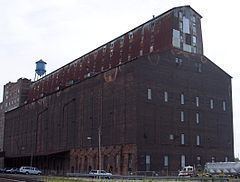Status Complete Completed September 29, 1897 Opened 29 September 1897 | Architectural style Brick Box Silo Height 57 m Construction started 31 March 1897 | |
 | ||
Former names Mutual Elevator, Pillsbury Elevator Type Intermediate Steel Elevator Location 250 Ganson Street, Buffalo, NY, United States Similar Concrete‑Central Elevator, Cargill Pool Elevator, Buffalo Savings Bank, Temple Beth Zion, Lafayette Square | ||
The Great Northern Elevator is a grain storage facility at 250 Ganson Street in Buffalo, New York. The elevator is located along Buffalo's "elevator alley" and at the time of its completion in 1897, the elevator was the world's largest. The mill was also one of the first to run on electricity.
Contents
Map of Great Northern Elevator, Buffalo, NY 14203, USA
History
The Great Northern Elevator was built by noted Chicago elevator builder D. A. Robinson. Max Toltz, a bridge engineer with the Great Northern Railroad was the consulting engineer for the building and responsible for much of the building design. The building is the last of the “brick box” type working house grain elevators still standing in North America.
Ownership
Storage
The Great Northern Elevator offered a total holding capacity of 2.52 to 3 million US bushels (89,000 to 106,000 m3) in 48 large steel bins. Thirty of the bins are 38 feet (12 m) in diameter and 18 of the bins are 15.5 feet (4.7 m) in diameter. The elevator's brick exterior serves as a weather barrier and does not help to carry the weight of the cupola or the grain bins. The building's structure is supported by a web of steel I-beams. The building was originally equipped with three corrugated-iron nine-story-high iron legs designed to move along tracks. These were destroyed during a storm in 1922 and replaced by two new 145-foot (44 m) marine leg towers built by the Monarch Engineering Co. A concrete framed flour mill addition was erected in 1924.
Present day
In the late 1980s, then-owner Pillsbury requested a permit to raze the structure. This was opposed, and culminated in the Great Northern’s designation as a city of Buffalo landmark. In 1996 and 2003 demolition of the building complex was again requested by subsequent and current owner Archer Daniels Midland (ADM). Both times it was denied. The building remains one of the earliest surviving elevators in the Buffalo River District.
